July 2005
The Daley News
Welcome to Winter
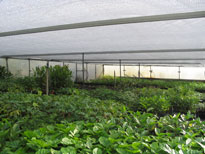 It is that time of the year again when we relish the opportunity to catch up on all the organisational jobs that we neglect through the busiest times. The twins are busy constructing sliding aluminate screens to protect our young plants from the threat of frost, these reflect the radiant heat of the day back in to the plants over night. It works in the same way that cloud cover does, the warmth of the earth radiates out at night and is reflected back to the earth by the aluminate keeping the temperature above freezing and preventing frost damage. (See the Daley News from July 2004 for more information on aluminate and frost protection (July Newsletter). For anyone who has any threat of frosts and is trying to establish a sub tropical orchard it will be vital for you to undertake some form of frost protection, do not wait until your small trees turn brown and wilt. Remember prevention is always better than a cure.
It is that time of the year again when we relish the opportunity to catch up on all the organisational jobs that we neglect through the busiest times. The twins are busy constructing sliding aluminate screens to protect our young plants from the threat of frost, these reflect the radiant heat of the day back in to the plants over night. It works in the same way that cloud cover does, the warmth of the earth radiates out at night and is reflected back to the earth by the aluminate keeping the temperature above freezing and preventing frost damage. (See the Daley News from July 2004 for more information on aluminate and frost protection (July Newsletter). For anyone who has any threat of frosts and is trying to establish a sub tropical orchard it will be vital for you to undertake some form of frost protection, do not wait until your small trees turn brown and wilt. Remember prevention is always better than a cure.
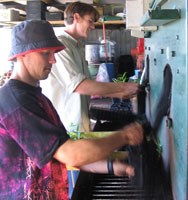 The young men are resurfacing the underside of the weed matting, they spread blue metal to level the ground lay the weed mat and reorganize the plants. This is a great winter job, it has the effect of making the nursery very neat, tidy and organised as well as keeping the young lads fit through winter. It is a great opportunity to monitor our plant protection techniques while there are few pest and diseases active. While the men are busy, the women are in charge of production and propagation. We have filled the propagation house with cuttings taken in the autumn and are busily potting up in preparation for the spring.
The young men are resurfacing the underside of the weed matting, they spread blue metal to level the ground lay the weed mat and reorganize the plants. This is a great winter job, it has the effect of making the nursery very neat, tidy and organised as well as keeping the young lads fit through winter. It is a great opportunity to monitor our plant protection techniques while there are few pest and diseases active. While the men are busy, the women are in charge of production and propagation. We have filled the propagation house with cuttings taken in the autumn and are busily potting up in preparation for the spring. 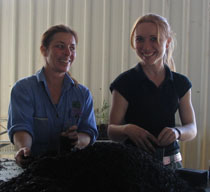 It comes around quick in this part of the world. We will soon be grafting our deciduous stocks and we are harvesting and grafting the first of the avocados.
It comes around quick in this part of the world. We will soon be grafting our deciduous stocks and we are harvesting and grafting the first of the avocados.
It is however in the office where all the big changes are occurring this year as we are in the process of developing our web site further and updating our computerized systems. We are hoping this will be an exciting development for you our customers as well as it is for us, to embrace the new system we will be offering our customers some very special offers, including the chance to purchase Louis Glowinski's fantastic book, The Complete Book of Fruit Growing in Australia at cost price. This year Daleys Nursery is celebrating our 25th birthday and we would like to offer you our customers a very special offer to show our appreciation of your support and continued interest in our business and product. Details will be in the next newsletter on how to win a free sub tropical orchard.
Jaboticaba – Myrciara cauliflora
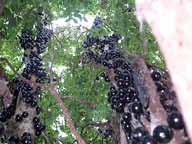 Native to Brazil, the Jaboticaba is a beautiful, unusual tree that is a wonderful addition to a sub tropical or tropical garden. It is a highly ornamental specimen tree, which looks stunning when fruiting or flowering as these occur along the branches and trunk of the tree. The fruits are shiny deep purple to almost black and taste very similar to grapes, except the skin is thicker, tougher and more turpentine. Best-enjoyed fresh jaboticabas are usually eaten by splitting the skin and sucking the flesh out from the inside, the skin is then discarded, and although it is not toxic, it does over power the beautiful grape like flesh. Easily eaten around the large seeds are also discarded.
Native to Brazil, the Jaboticaba is a beautiful, unusual tree that is a wonderful addition to a sub tropical or tropical garden. It is a highly ornamental specimen tree, which looks stunning when fruiting or flowering as these occur along the branches and trunk of the tree. The fruits are shiny deep purple to almost black and taste very similar to grapes, except the skin is thicker, tougher and more turpentine. Best-enjoyed fresh jaboticabas are usually eaten by splitting the skin and sucking the flesh out from the inside, the skin is then discarded, and although it is not toxic, it does over power the beautiful grape like flesh. Easily eaten around the large seeds are also discarded.
 Jaboticabas are very slow growing and can take up to eight years to fruit from seed. They are either a large shrub or a small tree with multiple stems; the profuse branching begins close to the ground, slanting upward and outward so the tree forms a dense canopy as wide as it is tall. The thin outer bark flakes and peals, like that of a guava, leaving very ornamental pale blotches on the trunk. It is not necessary to prune a Jaboticaba however; they respond well to cutting and shaping and they make a beautiful hedge. Hedging does not affect the fruit, as this appears along the stems and branches’, it also exposes the beautiful bark and trunk adding to the ornamental appeal of this lovely tree.
Jaboticabas are very slow growing and can take up to eight years to fruit from seed. They are either a large shrub or a small tree with multiple stems; the profuse branching begins close to the ground, slanting upward and outward so the tree forms a dense canopy as wide as it is tall. The thin outer bark flakes and peals, like that of a guava, leaving very ornamental pale blotches on the trunk. It is not necessary to prune a Jaboticaba however; they respond well to cutting and shaping and they make a beautiful hedge. Hedging does not affect the fruit, as this appears along the stems and branches’, it also exposes the beautiful bark and trunk adding to the ornamental appeal of this lovely tree.
Jaboticabas crop heavily once they start to fruit and trees will produce several crops each year. The fruits do not ripen all at once; they need to picked at two-day intervals. They make a fantastic wine, as the fruits are similar to a black Muscat grape in nature, they are delicious as a juice, jelly or fruit sauce, James J. Darley also highly recommends jaboticaba liqueur in his excellent book, Know and Enjoy Tropical Fruit.
Small Leaved Tamarind-Diploglottis campbellii
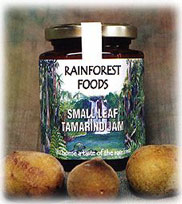 The small-leaved tamarind is a victim of extensive clearing of the rainforest in its natural range; as a result, it is high on the rare and endangered list. There may be as few as thirty trees remaining in a few sites of riverine rainforest near the Tweed and Richmond river valleys. A handful of large specimens up to 25m remain but most are in the open with a smaller spreading attractive form. It is vital that these trees and their forest home are protected. The small-leaved tamarind is now widely planted in rainforest plantings, bush food gardens and back yards, ensuring that not only does this beautiful and tasty species survive, but also that harvested fruits are from plantation trees and not the wild stock. The 3-6cm rounded, three lobed fruits are bright red and juicy although acid. They make a delicious wild jam or jelly along with a very refreshing drink. Rainforest Foods are renowned for their bush food jams including a delicious
The small-leaved tamarind is a victim of extensive clearing of the rainforest in its natural range; as a result, it is high on the rare and endangered list. There may be as few as thirty trees remaining in a few sites of riverine rainforest near the Tweed and Richmond river valleys. A handful of large specimens up to 25m remain but most are in the open with a smaller spreading attractive form. It is vital that these trees and their forest home are protected. The small-leaved tamarind is now widely planted in rainforest plantings, bush food gardens and back yards, ensuring that not only does this beautiful and tasty species survive, but also that harvested fruits are from plantation trees and not the wild stock. The 3-6cm rounded, three lobed fruits are bright red and juicy although acid. They make a delicious wild jam or jelly along with a very refreshing drink. Rainforest Foods are renowned for their bush food jams including a delicious  tamarind jam. Fruits come off in mid summer and are attractive to birds and animals as well as people. Growing small-leaved Tamarinds does require some patience, they can be slow to begin with but additional water and fertiliser will keep them looking beautiful in all stages of their growth. They do require a sheltered position and will not tolerate frosts or drought, flowering and fruiting commences at an early age, if given the right conditions, they are hardy, attractive steady growers that need little or no attention.
tamarind jam. Fruits come off in mid summer and are attractive to birds and animals as well as people. Growing small-leaved Tamarinds does require some patience, they can be slow to begin with but additional water and fertiliser will keep them looking beautiful in all stages of their growth. They do require a sheltered position and will not tolerate frosts or drought, flowering and fruiting commences at an early age, if given the right conditions, they are hardy, attractive steady growers that need little or no attention.
Brush Box – Lophostemon confertus
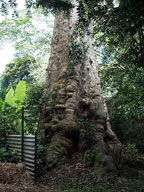 The brush box is a beautiful tree that is common in warmer types of rainforest north from Newcastle to Bowen in Queensland. Brush box is an emergent tree, being one of the first to colonise an area therefore protecting the establishing rainforest below its canopy. It is an incredibly long-lived species of tree; if anyone has visited Green Mountains in Southern Queensland, you will be familiar with the spectacular specimens of ancient brush box living in Lamington Nation Park. Some are huge and hollow, wide enough to drive a car under, others are gnarly and lumpy, all of them are giants, their beautiful smooth salmon coloured trunks stretching skyward above their orchid adorned rough barked bases. The flowers of the brush box are small but stunning, they are like white fluffy edged windmills, they are not frequently seen, as they are usually high in the canopy. This is an excellent pioneer tree for any rainforest planting, it is hardy if the soil has adequate moisture levels and is a fast growing straight tree, it is a great tree for parks or open gardens where the colour of its trunk can be enjoyed. It grows well in wood lots as technological advances have made it possible to process the attractive reddish-brown timber. Brush box grows to about 40 meters under ideal conditions and is a wonderful tree to use as a host for epiphytic orchids.
The brush box is a beautiful tree that is common in warmer types of rainforest north from Newcastle to Bowen in Queensland. Brush box is an emergent tree, being one of the first to colonise an area therefore protecting the establishing rainforest below its canopy. It is an incredibly long-lived species of tree; if anyone has visited Green Mountains in Southern Queensland, you will be familiar with the spectacular specimens of ancient brush box living in Lamington Nation Park. Some are huge and hollow, wide enough to drive a car under, others are gnarly and lumpy, all of them are giants, their beautiful smooth salmon coloured trunks stretching skyward above their orchid adorned rough barked bases. The flowers of the brush box are small but stunning, they are like white fluffy edged windmills, they are not frequently seen, as they are usually high in the canopy. This is an excellent pioneer tree for any rainforest planting, it is hardy if the soil has adequate moisture levels and is a fast growing straight tree, it is a great tree for parks or open gardens where the colour of its trunk can be enjoyed. It grows well in wood lots as technological advances have made it possible to process the attractive reddish-brown timber. Brush box grows to about 40 meters under ideal conditions and is a wonderful tree to use as a host for epiphytic orchids.
Special Offer
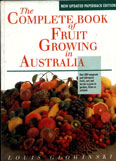 This month, July 2005 we are offering our customers the opportunity to purchase Louis Glowinski’s book, The Complete Book of Fruit Growing in Australia at cost price plus postage and packaging. Normally retailing at $55.00, we are offering the special price of $42 that includes postage and packaging to anywhere in Australia. For anyone who is placing a mail order with us you will not have to pay the postage so take advantage of the bargain price of $33.00. This offer is valid until the end of October 2005 so you all have plenty of time to select your choice of wonderful fruit trees to go with it.
This month, July 2005 we are offering our customers the opportunity to purchase Louis Glowinski’s book, The Complete Book of Fruit Growing in Australia at cost price plus postage and packaging. Normally retailing at $55.00, we are offering the special price of $42 that includes postage and packaging to anywhere in Australia. For anyone who is placing a mail order with us you will not have to pay the postage so take advantage of the bargain price of $33.00. This offer is valid until the end of October 2005 so you all have plenty of time to select your choice of wonderful fruit trees to go with it.






